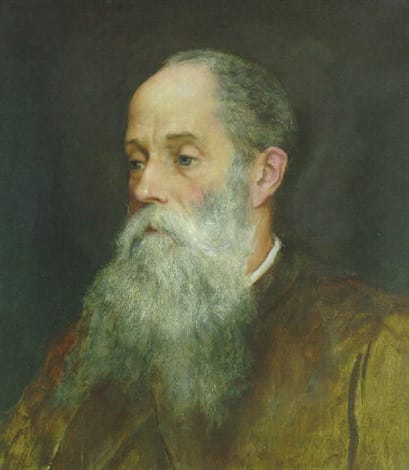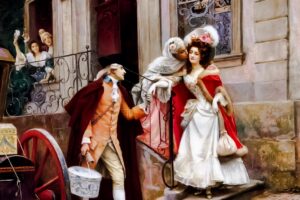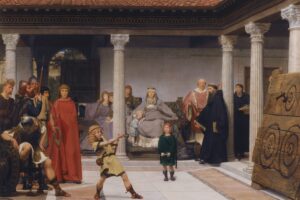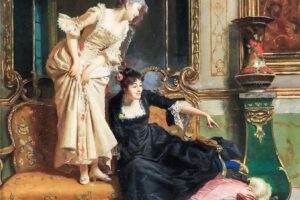Table of Contents
Pastoral Hymn of Love and Innocence
John Roddam Spencer Stanhope’s The Shulamite (Pastoral Scene with Lambs), painted in c. 1878, is a luminous vision shaped by the ideals of the Pre-Raphaelite Brotherhood. Rooted in biblical poetry and pastoral romance, the work draws upon the Song of Songs, that ancient hymn to love and beauty. With jewel-like tones, precise natural detail, and a dreamlike stillness, Stanhope creates a scene that is at once sacred and earthly, timeless and tender.
The Scene Before Us
A young woman in green and crimson robes stands among tall, slender trees, carrying a lamb in her arm while offering a sprig of blossoms in her hand. Around her, sheep graze peacefully, and figures in bright garments linger by a stream and among the woodlands. It is a pastoral world untouched by hardship, where labor and leisure blend in quiet harmony. The Shulamite, drawn from Solomon’s love poem, is the heart of the scene: serene, noble, and radiant.
The Deeper Meaning
The Shulamite has long symbolized purity, devotion, and the power of love. In the Song of Songs, she speaks with a voice that is deeply personal yet transcendent, celebrating the beauty of desire as something sacred. Stanhope translates this voice into imagery, giving her both regal dignity and pastoral humility. The lamb in her arms suggests innocence and sacrifice, while her steady gaze and graceful gesture speak of faith and fidelity. Through her, love is elevated beyond romance into a spiritual truth.
A Landscape of Stillness and Harmony
The landscape itself is a vital presence in the painting. Tall cypress and pine trees rise into the sky, framing the figures with their dark trunks. The gentle hills and distant rocks evoke an eternal countryside, more imagined than real. Every detail, from the folds of garments to the blades of grass and the tranquil flock, has the clarity of a miniature jewel. This harmony between people, animals, and nature reflects the Pre-Raphaelite vision of returning to a purer, more truthful art—one that unites observation with imagination.
The Pre-Raphaelite Spirit
Stanhope, a close associate of Edward Burne-Jones and other Pre-Raphaelites, painted in the spirit of the movement’s guiding ideals. Rejecting the conventions of academic painting that followed Raphael, these artists sought inspiration in medieval art, biblical poetry, and the luminous detail of early Renaissance masters. In The Shulamite, we see these principles at work: the clarity of form, the jewel-like color, the delicate layering of symbolic meaning. It is a picture both of devotion and of escape—a retreat into beauty and purity in a rapidly industrializing world.
A Moment Caught in Time
What makes the painting so moving is its suspension of time. The figures do not hurry, the animals do not scatter, the woman does not falter in her step. All is poised in perfect stillness, as if preserved in memory. The Shulamite becomes not just a figure from scripture but a timeless emblem of love, innocence, and serenity. The viewer is invited to linger with her, to walk slowly through this painted garden of devotion.
Stanhope’s The Shulamite continues to inspire because it brings together themes that are both intimate and universal. It is a meditation on love, a hymn to nature, and a vision of purity set against the clamor of modern life. Its pastoral calm speaks across centuries, reminding us that art can capture the eternal—faith, beauty, devotion—in a single, enduring image.
About Artist

John Roddam Spencer Stanhope (January 20, 1829 – August 2, 1908) was an English artist associated with the second wave of the Pre-Raphaelite movement. Born into an aristocratic family in Cawthorne, Yorkshire, he was educated at Rugby School and Christ Church, Oxford. Despite his privileged background, Stanhope pursued a career in art, training under George Frederic Watts and traveling extensively, including trips to Italy and Asia Minor.
Artist Style and Movement
Stanhope’s work is typically classified within the later Pre-Raphaelite and Aesthetic movements of Victorian art. He worked across various media—oil, watercolor, fresco, tempera—and his subjects ranged from mythological and allegorical themes to biblical scenes and contemporary life. His early paintings featured highly original narrative compositions, which later evolved towards a more symbolic and aesthetic style influenced by broader Victorian artistic trends.
Artwork Profile
- Thoughts of the Past (1859), his first exhibited painting, depicting a contemplative woman by a window overlooking the Thames.
- The Shulamite: (Pastoral Scene with Lambs) (c. 1878), a serene and lyrical pastoral scene exemplifying his Pre-Raphaelite style.
- The Shulamite: (Bridal Procession) (c. 1882), depicting the procession with rich symbolism and ornate detail, continuing his Pre-Raphaelite themes.
- Penelope (1864), illustrating the faithful wife from Homeric legend in the detailed and expressive Pre-Raphaelite manner.
- Winnowing (c. 1880), portraying agricultural life with symbolic overtones typical of his narrative approach.
- Juliet and Her Nurse (c. 1860), a literary subject rich with emotional and dramatic qualities favored by Pre-Raphaelites.
- Why Seek ye the Living Among the Dead (1870–1899), a powerful biblical scene reflecting later symbolic and aesthetic tendencies.
- Love and the Maiden (1877), a romantic and allegorical composition showcasing his mature style.
- Charon and Psyche (1883), a mythological painting exploring themes of love and the afterlife.
- Pine Woods at Viareggio (1888), a landscape reflecting his time in Italy with delicate naturalism.
- The Gentle Music of a Bygone Day (1873), a nostalgic genre painting evoking memories and emotion.
- The Waters of Lethe by the Plains of Elysium (1880), a symbolic work referencing classical mythology and the afterlife.
John Roddam Spencer Stanhope’s artistic career reflects a rich engagement with the ideals of the Pre-Raphaelites, combined with a move towards aesthetic symbolism in later years. His work, characterized by technical skill and narrative depth, secured him a distinctive place in Victorian art history. Living much of his later life in Florence, he influenced subsequent artists including his niece Evelyn De Morgan, solidifying his legacy as a key figure bridging English Romanticism and Aestheticism.phasize classical virtue and patriotic sacrifice, reflecting the cultural ideals of his age.



